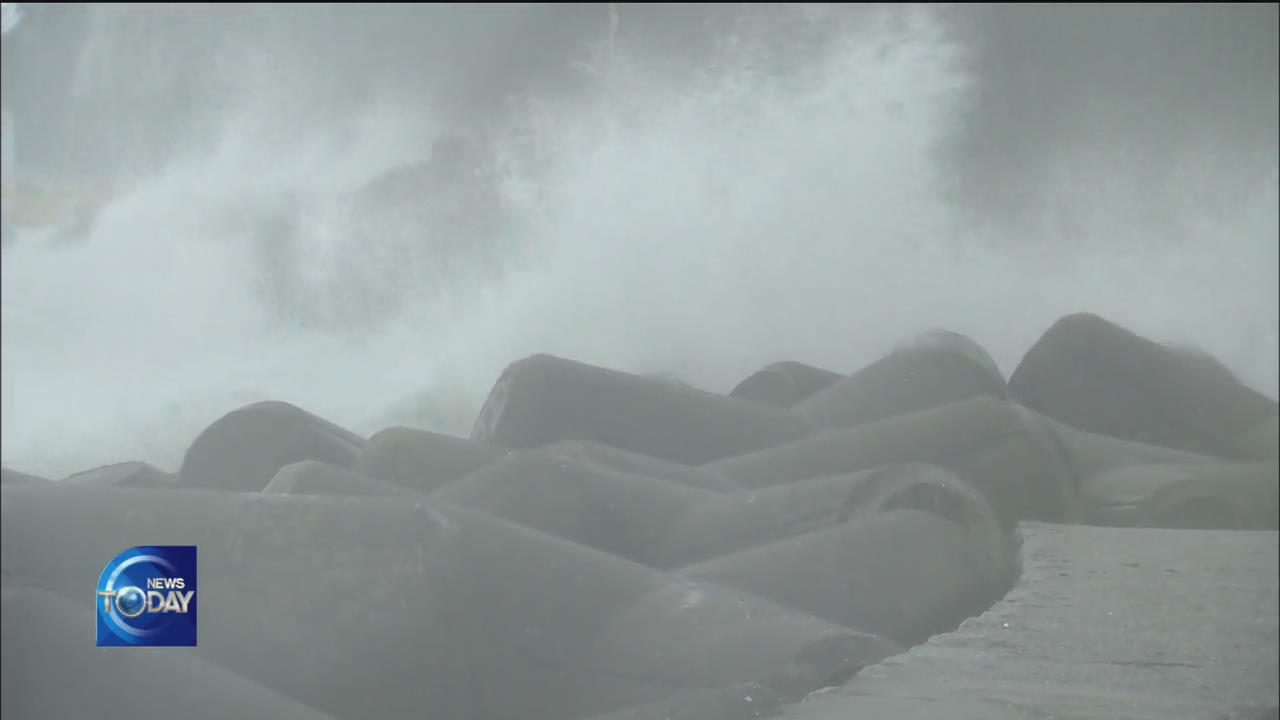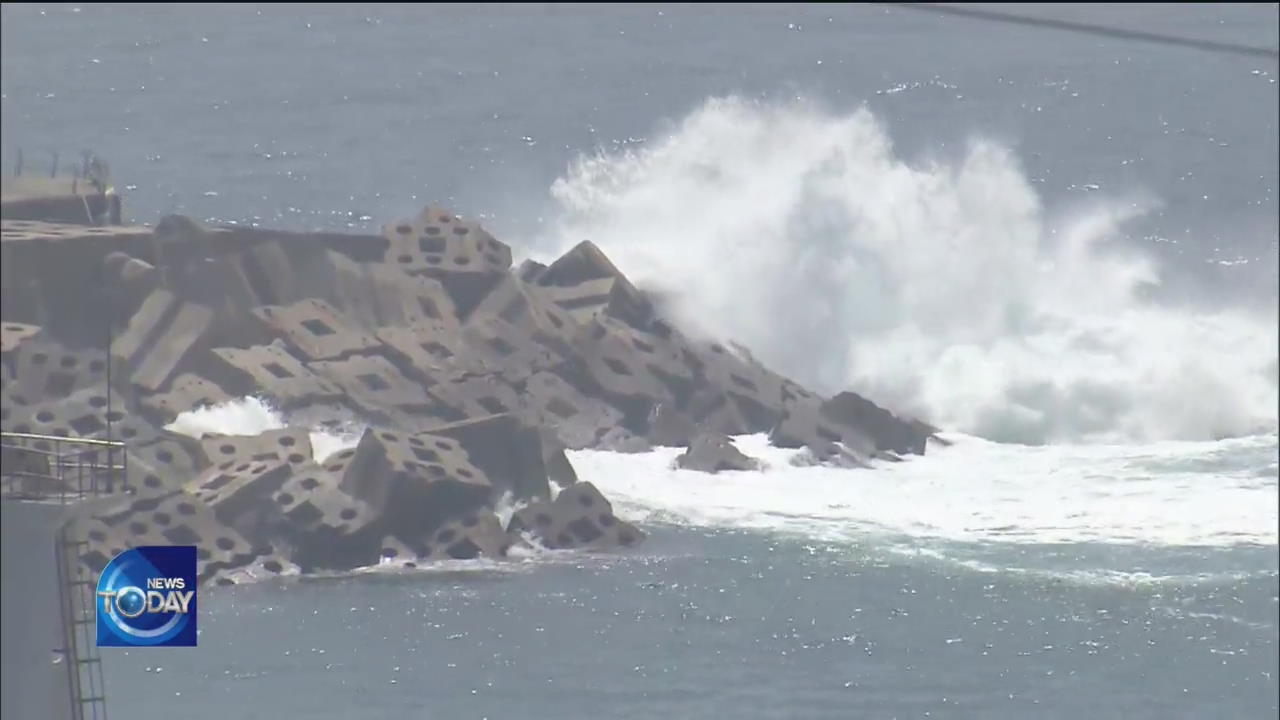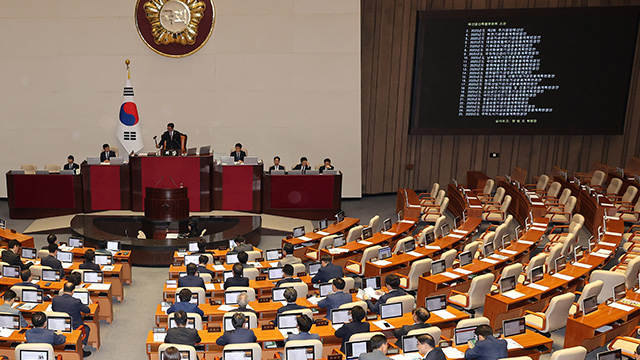TYPHOON BAVI TO HIT THE KOREAN PENINSULA
입력 2020.08.25 (15:12)
수정 2020.08.25 (16:47)
읽어주기 기능은 크롬기반의
브라우저에서만 사용하실 수 있습니다.
[Anchor Lead]
Typhoon Bavi, which is now making its ways toward the Korean Peninsula, is set to hit Jeju-do Island tonight. It's expected to strengthen into a super typhoon while passing through a high-temperature freshwater zone in the West Sea, which originated from the Yangtze River in China. The eighth typhoon of this season is expected to be stronger than last year's Lingling. Here is more.
[Pkg]
A tree collapses before a moving vehicle. A roof, ripped off by strong winds, falls on a parked car. A broken utility pole is lying across the street. A pedestrian is pushed by strong winds towards a road. These videos were sent in by viewers when the nation was battered by Typhoon Lingling last September. Typhoon Bavi is currently moving northwards and is also predicted to bring menacing winds to the Korean Peninsula. Bavi has now become a mid-scale typhoon while passing over waters northwest of Okinawa, Japan. Its intensity is forecast to peak on Wednesday afternoon when traveling through the western part of Jeju-do Island. It's expected to develop into a super typhoon and make landfall near North Korea's Hwanghae-do Province early Thursday without losing much strength. The storm will unlikely reach South Korea's inland regions, but unlike Lingling, Bavi may get stronger while passing over the West Sea.
[Soundbite] WOO JIN-KYU(WEATHER FORECASTER) : "The approaching typhoon is predicted to strengthen quickly while passing through the west coast of Jeju-do island. It will likely move northwards, bringing winds stronger than those caused by last year's Lingling."
According to a chart on the expected levels of salinity in ocean water, the color green means a belt of freshwater, which is now coming from China toward waters south of Jeju. The enormous amount of freshwater was caused by flooding in the Yangtze River. The freshwater zone is expected to add strength to Bavi, as its density is low enough to cover the surface, with the high water temperature hovering around 30 degrees Celsius. The route of the typhoon can change a bit. But the entire Korean Peninsula is forecast to be affected as Bavi's radius of maximum wind is estimated at 420 kilometers.
Typhoon Bavi, which is now making its ways toward the Korean Peninsula, is set to hit Jeju-do Island tonight. It's expected to strengthen into a super typhoon while passing through a high-temperature freshwater zone in the West Sea, which originated from the Yangtze River in China. The eighth typhoon of this season is expected to be stronger than last year's Lingling. Here is more.
[Pkg]
A tree collapses before a moving vehicle. A roof, ripped off by strong winds, falls on a parked car. A broken utility pole is lying across the street. A pedestrian is pushed by strong winds towards a road. These videos were sent in by viewers when the nation was battered by Typhoon Lingling last September. Typhoon Bavi is currently moving northwards and is also predicted to bring menacing winds to the Korean Peninsula. Bavi has now become a mid-scale typhoon while passing over waters northwest of Okinawa, Japan. Its intensity is forecast to peak on Wednesday afternoon when traveling through the western part of Jeju-do Island. It's expected to develop into a super typhoon and make landfall near North Korea's Hwanghae-do Province early Thursday without losing much strength. The storm will unlikely reach South Korea's inland regions, but unlike Lingling, Bavi may get stronger while passing over the West Sea.
[Soundbite] WOO JIN-KYU(WEATHER FORECASTER) : "The approaching typhoon is predicted to strengthen quickly while passing through the west coast of Jeju-do island. It will likely move northwards, bringing winds stronger than those caused by last year's Lingling."
According to a chart on the expected levels of salinity in ocean water, the color green means a belt of freshwater, which is now coming from China toward waters south of Jeju. The enormous amount of freshwater was caused by flooding in the Yangtze River. The freshwater zone is expected to add strength to Bavi, as its density is low enough to cover the surface, with the high water temperature hovering around 30 degrees Celsius. The route of the typhoon can change a bit. But the entire Korean Peninsula is forecast to be affected as Bavi's radius of maximum wind is estimated at 420 kilometers.
■ 제보하기
▷ 카카오톡 : 'KBS제보' 검색, 채널 추가
▷ 전화 : 02-781-1234, 4444
▷ 이메일 : kbs1234@kbs.co.kr
▷ 유튜브, 네이버, 카카오에서도 KBS뉴스를 구독해주세요!
- TYPHOON BAVI TO HIT THE KOREAN PENINSULA
-
- 입력 2020-08-25 15:06:14
- 수정2020-08-25 16:47:02

[Anchor Lead]
Typhoon Bavi, which is now making its ways toward the Korean Peninsula, is set to hit Jeju-do Island tonight. It's expected to strengthen into a super typhoon while passing through a high-temperature freshwater zone in the West Sea, which originated from the Yangtze River in China. The eighth typhoon of this season is expected to be stronger than last year's Lingling. Here is more.
[Pkg]
A tree collapses before a moving vehicle. A roof, ripped off by strong winds, falls on a parked car. A broken utility pole is lying across the street. A pedestrian is pushed by strong winds towards a road. These videos were sent in by viewers when the nation was battered by Typhoon Lingling last September. Typhoon Bavi is currently moving northwards and is also predicted to bring menacing winds to the Korean Peninsula. Bavi has now become a mid-scale typhoon while passing over waters northwest of Okinawa, Japan. Its intensity is forecast to peak on Wednesday afternoon when traveling through the western part of Jeju-do Island. It's expected to develop into a super typhoon and make landfall near North Korea's Hwanghae-do Province early Thursday without losing much strength. The storm will unlikely reach South Korea's inland regions, but unlike Lingling, Bavi may get stronger while passing over the West Sea.
[Soundbite] WOO JIN-KYU(WEATHER FORECASTER) : "The approaching typhoon is predicted to strengthen quickly while passing through the west coast of Jeju-do island. It will likely move northwards, bringing winds stronger than those caused by last year's Lingling."
According to a chart on the expected levels of salinity in ocean water, the color green means a belt of freshwater, which is now coming from China toward waters south of Jeju. The enormous amount of freshwater was caused by flooding in the Yangtze River. The freshwater zone is expected to add strength to Bavi, as its density is low enough to cover the surface, with the high water temperature hovering around 30 degrees Celsius. The route of the typhoon can change a bit. But the entire Korean Peninsula is forecast to be affected as Bavi's radius of maximum wind is estimated at 420 kilometers.
Typhoon Bavi, which is now making its ways toward the Korean Peninsula, is set to hit Jeju-do Island tonight. It's expected to strengthen into a super typhoon while passing through a high-temperature freshwater zone in the West Sea, which originated from the Yangtze River in China. The eighth typhoon of this season is expected to be stronger than last year's Lingling. Here is more.
[Pkg]
A tree collapses before a moving vehicle. A roof, ripped off by strong winds, falls on a parked car. A broken utility pole is lying across the street. A pedestrian is pushed by strong winds towards a road. These videos were sent in by viewers when the nation was battered by Typhoon Lingling last September. Typhoon Bavi is currently moving northwards and is also predicted to bring menacing winds to the Korean Peninsula. Bavi has now become a mid-scale typhoon while passing over waters northwest of Okinawa, Japan. Its intensity is forecast to peak on Wednesday afternoon when traveling through the western part of Jeju-do Island. It's expected to develop into a super typhoon and make landfall near North Korea's Hwanghae-do Province early Thursday without losing much strength. The storm will unlikely reach South Korea's inland regions, but unlike Lingling, Bavi may get stronger while passing over the West Sea.
[Soundbite] WOO JIN-KYU(WEATHER FORECASTER) : "The approaching typhoon is predicted to strengthen quickly while passing through the west coast of Jeju-do island. It will likely move northwards, bringing winds stronger than those caused by last year's Lingling."
According to a chart on the expected levels of salinity in ocean water, the color green means a belt of freshwater, which is now coming from China toward waters south of Jeju. The enormous amount of freshwater was caused by flooding in the Yangtze River. The freshwater zone is expected to add strength to Bavi, as its density is low enough to cover the surface, with the high water temperature hovering around 30 degrees Celsius. The route of the typhoon can change a bit. But the entire Korean Peninsula is forecast to be affected as Bavi's radius of maximum wind is estimated at 420 kilometers.
이 기사가 좋으셨다면
-
좋아요
0
-
응원해요
0
-
후속 원해요
0

















이 기사에 대한 의견을 남겨주세요.